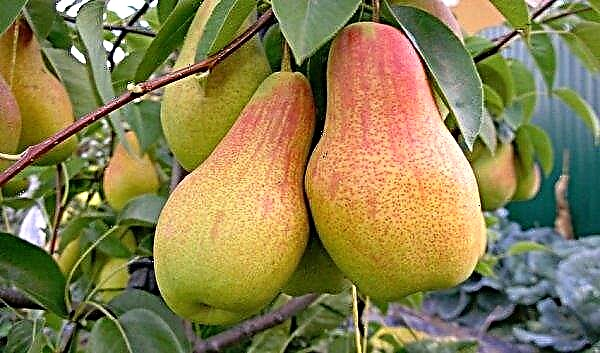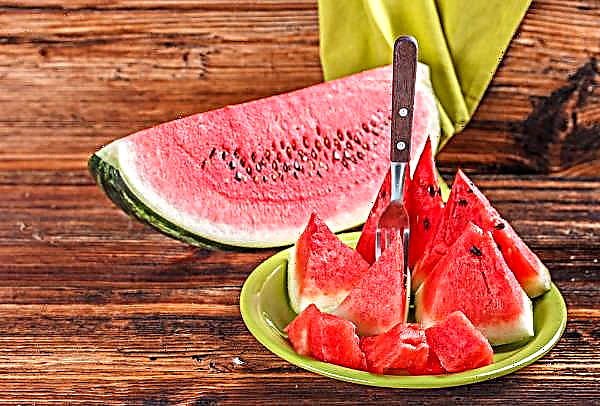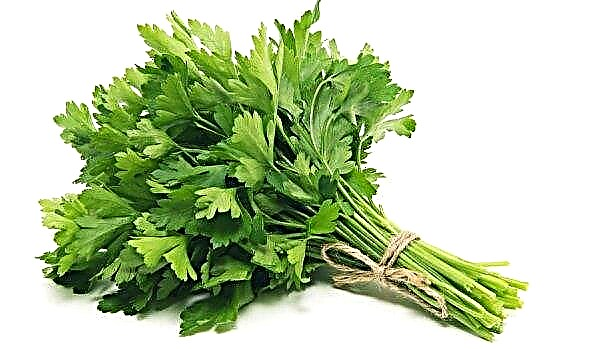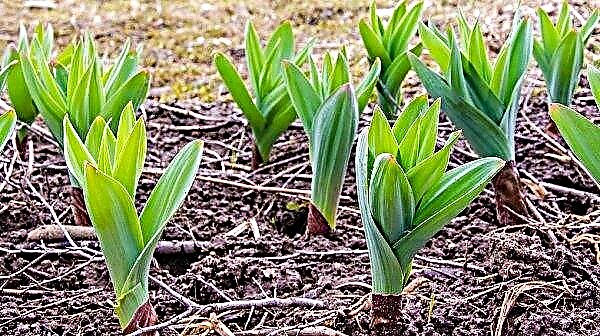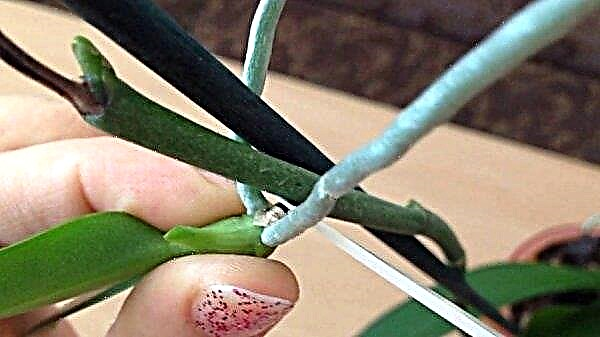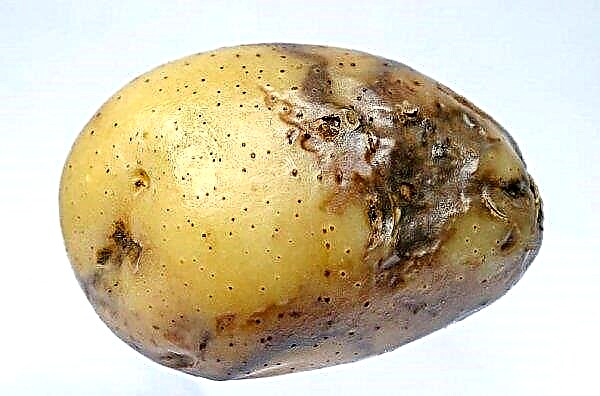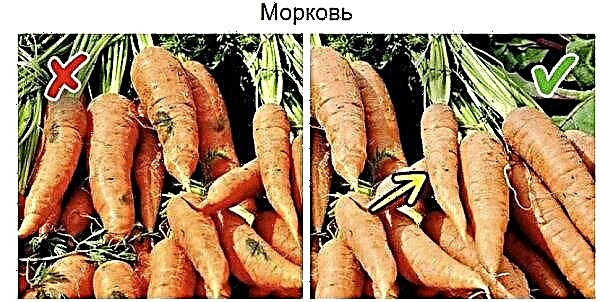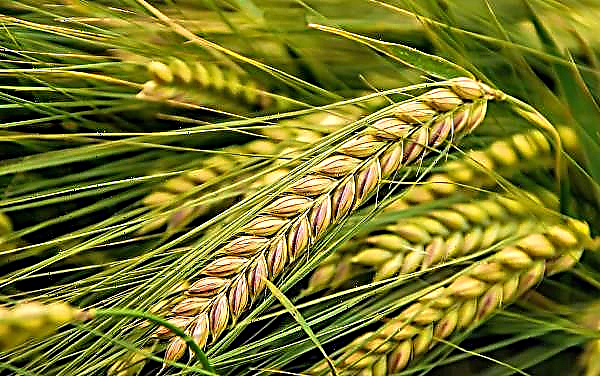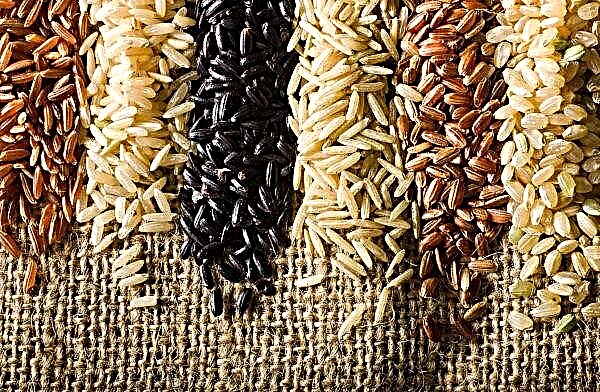White broad-breasted turkey appeared in America in the second half of the last century, but has already become the most popular among its relatives. It is distinguished by chic snow-white plumage and delicate meat, as well as fast mass gain. In this article, we will consider the differences between this turkey breed and talk about how best to care for the bird so that material costs will pay off in the shortest possible time.
Description and characteristics of the breed
The white broad-breasted turkey looks very noble: he proudly wears a lush caftan of white feathers with a black medallion on his chest. With its impressive size and beautiful appearance, it stands out among its relatives. An exception is the Hybrid Converter, which looks like White Broad-chested as his sibling. These breeds have similar external, productive and other characteristics.
But they can still be distinguished by some signs:
- The male Hybrid has a beaky red earring of a brighter color.
- The body of White broad-chested is vertically planted. This is clearly seen in females whose tails hang almost to the ground.
- Hybrids are more mobile, like to fly over fences.
Types of White Broad-Breasted Turkeys
White broad-breasted are divided into three types, or weight groups:
- Easy: the weight of males is from 9 to 10 kg, and of females is 5–6 kg. This species is adapted for maintenance in cells, therefore it is bred at industrial poultry farms.
- Average: males weigh 15–17 kg and females weigh 7–8 kg. The weight of the chicks at 3 months is already 4 kg.
- Heavy: turkeys grow up to 25 kg (some up to 30 kg), turkeys up to 11 kg, chicks weigh more than 5 kg in 3 months.
Appearance
The appearance of the White broad-chested corresponds to its name - it is a rather large bird with a powerful chest and a snow-white feather cover. The main external parameters are presented in the table:
| Appearance | |
| Dimensions | males - up to 25 kg, females - up to 11 kg |
| Torso | large, oval, upright |
| Head | without plumage, pale red |
| Crest | missing |
| Beak | white with a long red growth |
| Rib cage | wide, massive |
| Wings | the female is tightly pressed to the body, the male is lowered down |
| Tail | in males in an excited state forms a round fan |
| Paws | powerful, widely spaced, pink |
| Plumage and color | thick, white, black spot on the chest. |
Did you know? The leathery earring above the beak of the male can be modified. When it moves, it lengthens, in an excited state, it expands and blushes. And at rest, the growth again decreases and turns pale.
Productive qualities
White broad-chested are meat breeds.
Their representatives have a good level of productivity:
- high meat yield;
- egg production is average.
Egg production
The turkey begins to rush at the age of 9 months. The egg-bearing season lasts 6–9 months. During this time, 100–120 eggs can be obtained from one female.

Egg Feature:
- weight - 80–85 g;
- color beige with brown spots;
- the shell is dense and very strong;
- fertilized 90% of eggs;
- hatching of chicks at the level of 75%.
Meat yield at slaughter
White turkey poultry is planted most often in order to obtain tasty meat. A big plus of this breed is that babies grow quickly and gain good weight by the age of 2 months. At this age they can be slaughtered.

The best time for slaughter turkey poults:
- 2 months - the minimum period;
- 3–3.5 months - the optimal age for slaughter in order to get the maximum benefit at the lowest cost;
- 6 months is the maximum beneficial period.
Important! Keeping turkeys for meat for more than six months does not make sense. From this time on, weight gain slows down, and feed consumption and expenditure increase.
Weight gain for months:
- at 2 months: 2–2.5 kg;
- at 3 months: light turkey poults - about 3 kg, medium - 4 kg, heavy - more than 5 kg;
- at 6 months (respectively): 5 kg, 7 kg, 10–11 kg.
Advantages and disadvantages
Judging by the feedback of experienced farmers, it is very profitable to grow turkeys of this breed.
- Benefits
- fast growth;
- large meat yield after slaughter;
- healthy and tasty meat;
- good egg production and breeding;
- ease of care;
- payback in 5-7 months.
- disadvantages
- high consumption of feed and water;
- need for daily walking;
- the need for a spacious room;
- keeping separate from other poultry.
Did you know? Turkeys came to Europe in the 16th century. Then they were called Native American roosters and bred not for meat, but to get their beautiful bright feathers.
How to choose good individuals
In order for a purchase of turkey poultry to be successful and without unpleasant surprises, several important points should be taken into account. Firstly, it is advisable to buy chicks at the poultry farm - so you can be completely sure of their thoroughbred. Secondly, you need to choose healthy turkey poults - this can be judged by their appearance and behavior.

Chicks are healthy if they have:
- the fluff is clean;
- under the tail, dry, clean, without dried secretions;
- the umbilical cord does not hang;
- the tummy is not swollen;
- the wings are closely squeezed to the body;
- reflexes are well developed - if you tap on the wall of the box, healthy chicks run to knock.
Breeding White Broad-Breasted Turkeys
White broad-breasted turkeys proved to be excellent hens. One female can sit on 20 eggs. Without murmuring, she incubates the eggs and duck eggs enclosed to her. Offspring are hatched after 27–32 days. A feathered mother takes care of the chicks until they become independent.

The disadvantage of the hens is that they are clumsy and can accidentally crush an egg or injure a cub. It is safer to remove chicks in an incubator.
Incubation Rules
For incubation, the best eggs are selected without any flaws. The selection is carried out by examining the external and internal condition (using an ovoscope) of the egg.
Inappropriate eggs are rejected.
Suitable specimens should have the following characteristics:
- the shell is smooth and even, without roughness, growths and cracks;
- the shape is regular, elongated;
- medium size;
- color beige or light brown with dark brown spots;
- one yolk, located in the center, a little mobile when cornering.

Rules for storing eggs before incubation:
- term - up to 10 days;
- temperature - 12 ° С;
- humidity - 80%;
- dry place;
- the eggs are stored in a pointed end down and turn over after 4 days.
Stepwise incubation:
- The specimens selected and stored for the incubator should be heated to 20 ° C before laying. Due to this, there will be no condensation on the shell, which can interfere with the normal development of embryos.
- Disinfection of the incubator and heated eggs is carried out by dipping them in a warm solution of potassium permanganate (up to 40 ° C).
- The eggs are laid vertically in the cells of the automatic incubator. If there is no turning mechanism, then they are laid horizontally. For convenience, the sides of the eggs can be marked with a marker.
- During the first 14 days, the incubator maintains a temperature of 38 ° C and a humidity of 75%. Eggs should be turned 10-12 times a day. At the end of the first week they need to be again illuminated with an ovoscope and remove empty and damaged specimens.
- From 15 to 25 days, the temperature drops to 37.5 ° C, and humidity - up to 50%. The number of turns is 12.
- The bite begins on about 25 or 26 days. Turning over stops, the temperature drops to around 37 ° C, and humidity drops to 70%.
- Chicks hatch during the 27th and 28th days.
Features of care and maintenance
For three weeks newborn chicks are moved to a brooder, a special house with heating, in which the temperature should be maintained at 36 ° C and lighting around the clock. Humidity should not be lower than 70%. Ten days later, it can be reduced to 60%. Gradually, the temperature and duration of lighting decrease.

Three-week-old babies can be placed in cages located in a warm barn. They are resettled in 5 individuals per 1 square. m. For 1.5-month-old turkey poultry establish a normal lighting mode. When they grow up to 4 months, they can be transferred to adult housing, equipped specifically for them.
Housing requirements
Large broad-breasted turkeys are very demanding on living conditions. In poor conditions, they will be very sick. For birds, it is important that the room is warm, dry and adequate space.
Requirements for turkey poultry:
- Sizes: one bird should have at least 1 square meter. m of space so that it can move freely, and the floor must be raised 25 cm from the ground.
- Temperature: in summer - not higher than +25 ° C, and in winter - not lower than +5 ° C.
- Humidity: the room should be dry enough and without drafts. You can get rid of dampness with the help of a hood or ventilation windows.
- Lighting: natural through windows. It is advisable that they face south or southwest. In winter, daylight hours increase with electric lamps up to 12-14 hours.
Home Improvement
For the comfortable maintenance of turkeys, the house should be equipped with everything necessary:
- Perches are built from strong bars that can withstand heavy birds. They are fixed at a height of 80 cm from the floor and 60 cm from each other. Place on the bars is calculated as follows: 40 cm per individual.
- Feeding troughs and drinking bowls can serve any containers and devices that are placed on the floor, on stands or suspended.

It is important that the sides of the dishes are not lower than the level of the turkey’s chest, so that no debris, litter or splashing water gets into it. When feeding and drinking, each head should have 20 cm of the size of the feeder, and a drinker of 4 cm.
- Nests: boxes (60x60 cm), covered with straw and with an opening on the side for entry, are placed in a poorly lit corner of the house.
- Litter on the floor of a thick layer of hay, straw or sawdust.
Walking organization
A daily walk in the pasture is a prerequisite for keeping White broad-breasted turkeys. The lack of such an opportunity will lead to obesity, which will negatively affect the health of birds and the taste of their meat.
Place for walking should be:
- very spacious so that there is enough space for everyone to walk;
- seeded with delicious grass - clover or alfalfa;
- equipped with drinking bowls;
- fenced by a high fence, which will not allow the feathery heavyweights fly away and protect them from the wind.

Feeding
Of particular importance for normal development, rapid weight gain and good health is the feeding of the described birds. The role is played not only by what products they can be given and which not, but also by the diet, and how to prepare the feed. It is necessary to feed adult birds and babies separately and from different dishes. Their diet is also different.
Adults

Their menu changes depending on the time of day and year:
- wet cereal mixtures are served for breakfast and lunch;
- dry cereals and sprouted grains for dinner;
- in summer, fresh grass is added to wet dishes;
- in winter, vegetables (carrots, beets and cabbage) and steamed dried grass are added.
Products that are included in a turkey diet:
- compound feed;
- cereals - corn, barley and wheat;
- juicy food - fresh herbs, grated vegetables (fresh and boiled);
- peas;
- wheat bran;
- sunflower meal;
- mineral additives - yeast, meat and bone meal, fish meal, chalk, shells, salt;
- special vitamin supplements.
Important! The more juicy food the turkey consumes, the juicier and more tender the meat will be.
Turkey
The first meal for newborns is a mixture of small cereals and chopped boiled eggs. Instead of cereals, you can use grain flour, for example, corn. You can drink them with fresh milk, instead of water. They should be fed often - 8 times a day.

At the age of 1 month, turkey poults begin to feed with wet mixtures of cereal grains and green grass (young nettles and alfalfa). You can buy special feed for chicks, they already contain all the vitamins and minerals necessary for growth. But if desired, the mash is prepared independently.
Products that are added to wet mixtures:
- small or crushed cereals;
- eggs
- green grass;
- cottage cheese;
- yogurt, fresh milk or reverse;
- bone flour;
- fish fat.
Important! In no case can adult turkeys or young animals be given overdue compound feed or spoiled vegetables.
Disease prevention
Diseases that affect white broad-breasted turkeys:
- tuberculosis;
- smallpox
- coccidiosis;
- typhoid fever (pullorosis);
- respiratory mycoplasmosis;
- histomonosis;
- worms.
To protect the bird from these diseases, the following preventive measures should be followed:

- strictly observe the temperature and humidity standards in turkey poultry;
- make sure that there are no drafts in the room;
- regularly clean and timely disinfect the shed with slaked lime or special means;
- feed adult birds and young animals only with high-quality feed;
- from time to time organize a veterinarian examination of the flock and conduct timely vaccination;
- isolate individuals with signs of disease immediately.
Although turkeys of a white broad-breasted breed are quite demanding on the conditions of detention, the efforts are worth it - the result will be several kilograms of juicy and tasty meat. In addition, after 5 months you can fully recoup all costs.


